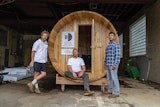Twitter is a social networking platform unlike any other. For businesses, it's a place where like-minded industry professionals and customers can share stories, ideas and useful content. It's also a great place to meet people in the industry or reach out to high-level contacts that would otherwise be hard to reach.
I've personally found a lot of success on Twitter. I use it every day to connect with industry professionals and other folks around the globe. I listen to people that talk about swimming pools or hot tubs and I respond. I also reach out to big companies and ask questions about their products.
I've been tweeting for almost three years now, and I finally figured out why I follow certain people and why I unfollow others. I've noticed a trend in the people who I started following and then quickly realized that they have nothing to offer or they're just annoying.
With that said, here is my list of the 10 dos and don'ts of Twitter.
1. Don't overuse #hashtags.
Using hashtags is a way to categorize your tweets. For instance, if you tweet about pool safety, you might want it to look like this:
"90 children under 15 reported to have drowned since Memorial Day. 72% were children under 5 #poolsafety"
By using #poolsafety as a hashtag, they will be more likely to find you if they're searching for tweets on pool safety. Even better, it can become a trending topic if others use the same hashtag.
You don't want your tweets to look like this:
"90 children under 15 reported to have #drowned since #MemorialDay. 72% were #children under 5 #poolsafety"
In this case, you're stuffing 4 hashtags into 1 tweet. When someone reads it, it looks like a bunch of links in a short sentence. Twitter automatically links all hashtags to their search page.
Bonus Tip: Use popular hashtags to increase your chances of being found and followed. Otherwise, create your own unique hashtag and use it on relevant tweets. For instance, If I were to tweet this article, I might use the hashtag #twit-tips or #twitter.
Lesson Learned: Do use hashtags, but use them wisely and sparingly.
2. Don't just retweet.
Twitter has introduced a new way to retweet. In the past, retweeting was just copying and pasting someone else's tweet and putting "RT (retweet)" in front of it.
Now, Twitter allows you to hit a button to retweet, but as if that person said it. There is nothing wrong with the new way of retweeting, but the old way allows you to add your own comment.
For example, this is the new Twitter retweet:

As you can see, this is how the tweet would show up in my feed, and it says it was retweeted by SwimUniversity. This does not allow you to add a comment. Also, it doesn't look like the tweet came from you.
Here is an example of an old style retweet that is much more personal:

The "RT" was placed in front of the tweet, the original tweet was retweeted, and I added my own comment at the end. In this case, I was responding to a question.
Lesson Learned: Retweet useful tweets and add your own comments or respond to questions.
3. Don't constantly self-promote.
If there is any "don't" that will decrease your follower count the fastest, it's this one!
When I'm following someone on Twitter, I expect a certain degree of self-promotion. However, if every tweet, or even every other tweet, talks about a new product you sell or a new piece of useless content on your site, I will unfollow you faster than you can tweet, "Check out the newest chlorine tablet we just started stocking. Only $89, hurry in while supplies last!"
With that said, there is nothing wrong with a little promotion, but you need to think of your followers first. Most of them didn't follow you so they can just learn about new products you sell. They want to engage and interact with you. They want you to provide really awesome links to stuff they'll like and answer their questions when they need you to.
Bonus Tip: Be useful on Twitter. Be an authority figure. Twitter is not a static advertising platform, or a bulletin board for you to promote on. Educate, inspire and be cool on Twitter.
Lesson Learned: Do self-promote awesome stuff, but do it lightly.
4. Don't tweet about your breakfast.
This is the common reason why people don't join Twitter in the first place. I've asked people from different companies why they're not on Twitter and they all say roughly the same thing: "I don't care what people had for breakfast."
There are tweeters who do that, but you don't have to follow them. It's that simple. However, it's nice to know that you're following a real person sometimes.
Companies who use Twitter have a tendency to automate their tweets and only tweet about things that are relevant to their industry, or to self-promote. While there is nothing wrong with this, sometimes people respond to more-personal tweets. For instance, you could sprinkle in some tweets talking about your family having a great time by the pool, or behind-the-scenes photos of your employees.
Bonus Tip: If you have a party for your company or a big tent sale, you can take pictures and share them on Twitter. People like that kind of stuff and will engage with you if they know there is someone behind the Twitter account and not just a robot.
Lesson Learned: Do tweet about yourself, you other interests, and behind-the-scenes content about your company to be more human.
5. Don't tweet several times in a row.
I'm sure you're not on Twitter all day long like me. You may check it in the morning or at the end of your day for about a half hour. So, that's the only time you're able to tweet. If this is you, you need to think about using a web-based Twitter program to help you space out your tweets.
It's annoying when one person tweets 20 times in a row and then not again until the same time the next day. Other followers don't use their Twitter accounts the same way. They may check them every hour or every 15 minutes. If they don't check when you decide to post 20 times, they will miss everything you tweet.
The program I use to space out my tweets is HootSuite. It's free for one user and one twitter account. It allows you to create tweets and schedule them throughout the day.
Bonus Tip: If you have a killer link you'd like to share, you can tweet about it several times in a day, but space them out. I suggest tweeting at 9am, 12pm, 3pm, and maybe 5 or 6pm. Twitter is very popular in the morning.
Lesson Learned: Do space out your tweets.
6. Don't tweet just to tweet.
Sometimes you'll think to yourself, "I haven't tweeted in a while. Let me just tweet something." The problem with this is, no one will care about your tweet if you don't care about it.
Throwaway tweets are worthless, and if you were a follower of someone with worthless tweets, you'd hate it too and unfollow them.
Instead, tweet only when you have something interesting to say or something cool to share.
Bonus Tip: If you have nothing to say, find something. Look around on the Internet for a killer piece of content that your followers will find useful. Don't just tweet, "I'm bored, LOL." No one cares that you're bored.
Lesson Learned: Do tweet when you have something interesting to say or awesome to share with your community of followers.
7. Don't follow EVERYONE that follows you.
Hopefully, as you start using Twitter to provide interesting and helpful tweets, others will follow. However, don't be obligated to follow them just because they followed you. They might just be an average Twitter user that tweets about their breakfast and retweets other people's content.
You want to keep your following count at a manageable level. I've seen other users following counts match their follower counts. Meaning, they follow everyone that follows them.
I'll be honest, this use to be me. I invested in a program that would follow other users related to my industry, then wait one week to see if they followed me back. If they didn't, the program would unfollow them and that's how I was able to get my follower count up so high.
The problem is, I couldn't keep up with 3,000 tweeters, and most of those users provided me with no real value. I decided to unfollow all 3,000 users and start over with 0 followers.
At that point, I actively searched out tweeters in the pool and spa industry that were tweeting useful content and meaningful stuff that would be a no-brainer for me to share or retweet with my own followers.
Now that my following count was lower and more manageable, I am able to engage with my small group effectively. Since then, my following count has grown naturally with users who are actually interested in what I have to say and share.
Lesson Learned: Do follow tweeters you are interested in, not just everyone who follows you.
8. Don't just follow people in the industry.
Remember, behind your company Twitter account, there is a human being who isn't just interested in swimming pools and hot tubs. Perhaps that person is interested in other related industries like grilling or landscaping.
Follow some influential tweeters outside your industry and you'll find that there is other unique content that your followers, or yourself, might be interested in.
For instance, I follow a chef who calls herself the Bikini Chef (@TheBikiniChef). She tweets about recipes, health tips, and she even sprinkles in some inspirational quotes. All in all, she's an excellent tweeter who has very little to do with the pool and spa industry.
You have to remember that most people are not passionate about their pools like we are. Our customers are passionate in the experience they get from enjoying the pool. You have to think outside the box. Tweeting about the effects of low pH is boring to the average pool owner, but tweeting about an awesome summer drink recipe to enjoy by the pool is something that a lot of people can get behind.
Lesson Learned: Do follow tweeters that share your other interests or related interests. Following other people outside your niche can lead to some powerful ideas for tweeting new and interesting content to your followers.
9. Don't ignore your direct messages.
Direct messages are like emails between Twitter users. Perhaps you'd like to reach out to a fellow tweeter, but you don't want others to know, or the information you want to share is private, like an email address or cell phone number.
The main reason why people ignore their direct message inbox is because a lot of tweeters set up an autoresponse when someone follows them. It will automatically send a direct message to your inbox with some stupid self-promoting tweet like, "Hey, thanks for the follow. You should check out my website cause I'm so freaking awesome." When your inbox is filled with junk like that, you start to ignore it.
This is another reason why you should only follow tweeters you are interested in and not try to follow everyone in the hopes that they'll follow you back to increase your follower count.
Lesson Learned: Do check and respond to your direct messages. Remember, you can send a direct message to only people who follow you.
10. Don't ignore retweets or tweets @ you.
You'll notice that you might retweet something and that user will send you a tweet thanking you for the RT. This shows that they're human and truly appreciate what you've done for them. It makes you feel warm inside and now you will pay a little more attention to that tweeter.
In this case, you should tweet back something like, "No problem! I found your tweet interesting and thought my followers might like it." You can make it more personal or shorter if you want.
If this was the real world and someone thanked you for doing something for them, you wouldn't just ignore them and walk away, would you? Of course not! You'd say, "You're welcome," at least.
The same rules for real world social etiquette applies on Twitter. If someone retweets one of your tweets, you should thank them for doing so; it's the right thing to do.
Also, if someone tweets @ you, for whatever reason, you'll want to respond quickly. You don't want to leave your followers hanging.
Lesson Learned: Do engage with everyone.
I hope you learned a lot about how to properly use Twitter. Take these dos and don'ts and apply them. If you're not on Twitter yet, I highly recommend that you sign up and join the conversation. I'm always looking for new tweeters to follow and engage with.
If you have any questions or additional tips for using Twitter, please share them in the comments below, or on Twitter!
You can follow me at @SwimUniversity











































